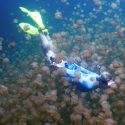This beautiful, majestic creature could kill you in a matter of minutes. But you didn’t know that, so you decided to touch it. Now, that excruciating pain you feel is its powerful venom entering your body. You’re dizzy and about to faint, but you must keep swimming back to shore. Cause this creature doesn’t travel alone. There could be 1,000 more of them coming your way.
This critter got its name as it resembles an 18th-century Portuguese warship under full sail. The Man o’ war is a type of siphonophore, a colony of multiple, genetically identical individuals living together to form a whole. And all members of a man o’ war work together as a killing machine. Its tentacles contain tiny capsules that fire darts loaded with a potent, fast-acting poison designed to capture fish.
In humans, it can cause welts on the skin. If you’re allergic, you could have a severe reaction and die. Why shouldn’t you pour freshwater on the sting? Why are man o’ wars more dangerous in the summer? How could gloves save your life?
Step 1. Don’t Move
Although a Portuguese man o’ war’s sting causes an enormous amount of pain, don’t start thrashing around or you could make it even worse. This creature’s tentacles can be as long as 50m (165 ft). The more you move, the more like you are to get entangled in the tentacles and stung by their barbs. Too many stings can cause you to go into anaphylactic shock. A life-threatening condition caused by a severe allergic reaction. To avoid that, slowly move away from the man o’ war.
Step 2. Beware of the Summer
It’s summertime. You’re ready to jump into the sea and have some fun, but slow down. Before getting in the water, check local beach reports and warning signs for the presence of man o’ wars, especially during this season. They reach full maturity in summer, so that’s when their venom is most powerful.
In the summer of 1987, a 67-year-old woman was exposed to almost 6 m (19.7 ft) of a Portuguese man o’ war’s tentacles. After it stung her, she stopped breathing, and the blood stopped flowing to her brain and organs. Unfortunately, she died.
Step 3. Use vinegar
Pouring freshwater on the wound might be your first instinct, but that would only make things worse. You just got out of the salty ocean. If you pour freshwater on your wounds, the change in salinity will release the venom still in the tentacles. Instead, rinse the wounds with saltwater or vinegar. That will inactivate the stingers and prevent them from releasing more toxins.
Step 4. Wear gloves
Now it’s time to pull the tentacles off your skin. They might be difficult to spot and remove but do your best to do it carefully. Never touch the tentacles with your bare hands, wear gloves or something that can protect your skin against those venomous barbs.
Step 5. Apply heat
In 2017, experts at the University of Hawai‘i – Mānoa discovered that after you put your wounds in vinegar, you’ll need to apply heat. Put the wounds in 45°C (113°F) water or apply a hot pack for 45 minutes. This helps to inactivate the venom that’s already in your body.
If you develop shortness of breath, chest pain and weakness you’ll need to seek medical attention right away.
You just survived getting stung by a Portuguese man o’ war. If you thought that was bad luck, how about getting bitten by one of the cutest marine creatures? This tiny thing has enough venom to kill 26 human adults, but you’re not going to be one of them because everything you need to get out alive is right here on How to Survive.
Sources
- “Urine Luck: Vinegar Is The Best Treatment For A Man O’ War Sting“. Magazine, Smithsonian, and Jason Daley.
- “Physalia Physalis (Portuguese Man-Of-War)“. 2022. Animal Diversity Web.
- “Fatal Portuguese Man-O’-War (Physalia Physalis) Envenomation”. Stein, Mark R, John V Marraccini, Neal E Rothschild, and Joseph W Burnett. 1989.Annals Of Emergency Medicine
- “Girl, 7, Stung By Portuguese Man-Of-War At Lawrencetown Beach | CBC News“. 2022. CBC.
- “What Is A Portuguese Man O’ War?”. 2022. Oceanservice.Noaa.Gov.
- “How To Survive A Portuguese Man O War Sting – According To Science“. 2020. Stone Age Man.

















